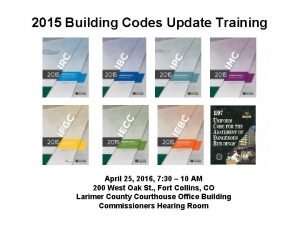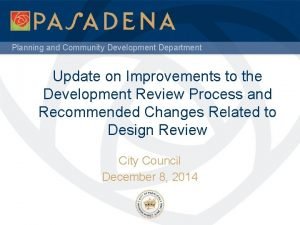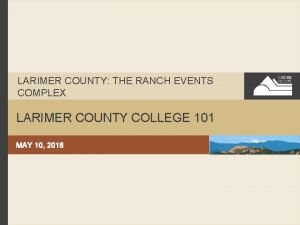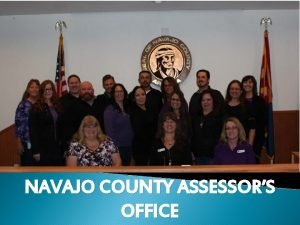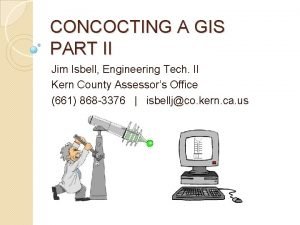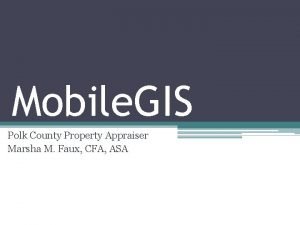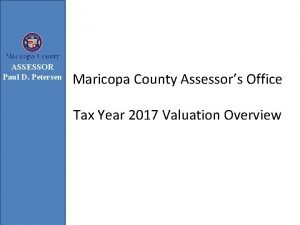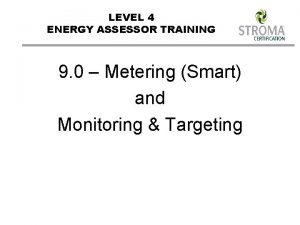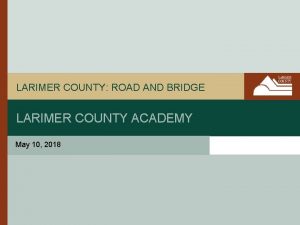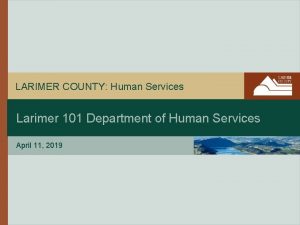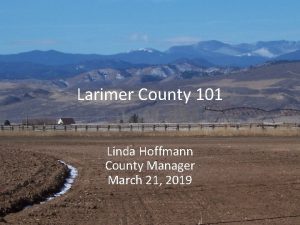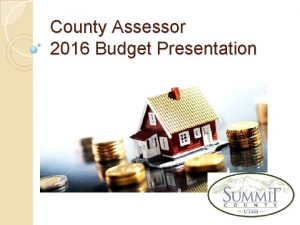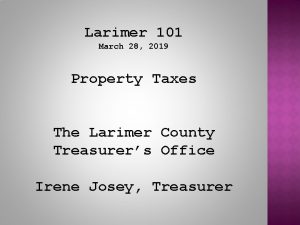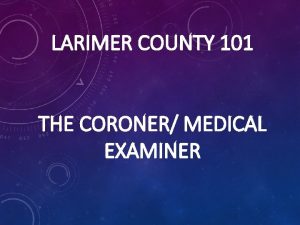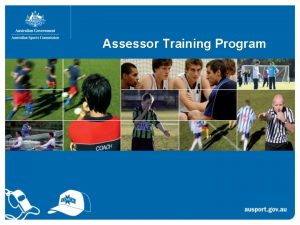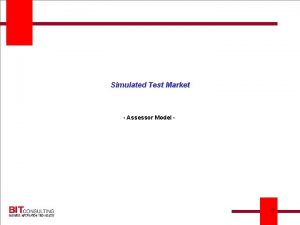LARIMER COUNTY ASSESSOR LC 101 MARCH 28 2019













- Slides: 13

LARIMER COUNTY ASSESSOR LC 101 MARCH 28, 2019


DISCOVER - LIST - CLASSIFY - VALUE • DISCOVER The discovery of property may be accomplished by field inspections; examining the records of the county clerk and recorder; reviewing building permits; and interaction with the property owners or inhabitants. This would also include assisting in Emergency Damage Assessments after natural disasters such as the 2013 Flood and the High Park Fire in 2012. • LIST The assessor coordinates with all the issuing authorities within the county to make sure we are receiving building permit data in a timely manner; from Berthoud to Wellington and Windsor to Estes Park. Listing includes the maintenance and updating of records to link properties to respective owners so that a current assessment file is created. � CLASSIFY Classification consists of determining the correct class for all property located in the county according to its use on the assessment date. The proper classification will have a bearing on both the method used to value the property and the assessment rate applied. Classification is also important when properties are compared in both the appeals and the valuation processes. � VALUE Property is valued by the assessor according to criteria specified by state statute. This includes notifying the taxpayer of the value and the administrative remedies that must be followed if the taxpayer disagrees with the assessor's valuation. The Assessor’s job is defined by Colorado State Statute with guidelines published in the Assessor’s Reference Library from the Colorado Division of Property Taxation and the Assessor must pass an independent audit every year.

ASSESSMENT CALENDAR January 1 st is the assessment date – Properties are assessed as of that date. If a property was vacant January 1 st but a house was built in March the Notice of Value sent in May will be for the Vacant Land. It is typically not prorated according to any Certificate of Occupancy or Permit Date. Business Personal Property Schedules are sent out January 1 st and are due back no later than April 15 th. The Treasurer’s Office mails tax bills in January. Current tax bills (2018 taxes due in 2019) are based on the 2017 Reappraisal cycle. These values are based on an appraisal date of June 30, 2016. REAPPRAISALS – This is typically when you will hear the most about what the Assessor does and updated property values. • All residential and commercial real properties are reappraised every 2 years in the odd-numbered year. Values for the 2019 reappraisal are based upon sales that occurred during the 24 months prior to June 30, 2018. � Notices of Value are sent to owners on or before May 1 st. Notices will also be available online at that time. Protests can be heard by the assessor's office from May 1 through June 1. Protests can be filed either in person, by letter, by fax or using the Online Protest System. � A protest will include a review of the facts on the property record; noting any discrepancies. For residential property items that may affect the value include the living area of the home, the presence or absence of a garage or finished basement, proximity to a lake or golf course, etc.

Besides the most obvious stuff… The Assessor is responsible for the following: • Process recorded title conveyance documents • Administer senior and veteran exemptions • Process annexations, subdivisions, plats, and similar property changes • Process changes of address (both site and mailing) • Update assessment maps and process parcel and taxing entity boundary changes • Assessment of property damage and ownership verification in the event of a natural disaster

But exactly HOW does the Assessor do all that… Let’s focus on the valuation of residential improved property. Characteristics that may impact residential property values: • Classification (Residential versus Agricultural property) • Location of property - Eco Area, Neighborhood, Subdivision • Square feet of living area • Square feet of basement • Square feet of finish in basement • Square feet of garage (attached and detached) • Design of home (Ranch, Two Story, Modular, Cabin, etc. ) • Quality of home • Locational attributes (Golf Course, Lake, Park, River, Railroad, Traffic, View, Greenbelt) Items that may be inventoried but do NOT typically impact residential value for assessment purposes: • Fixtures (sinks, showers, etc) • Sprinkler systems • Finished garage vs unfinished garage • Porches, decks or balconies • Bedroom and bathroom counts • Appliances • Updated roof or minor interior remodels

Where is my neighborhood? NBHD 19711 goes from Vine and Shields down to Mulberry and College then down to Prospect and Lemay and back up to Vine. Maps showing the Nbhds are available on our website.

Understanding the level of value of the 2019/2020 assessment cycle

How does property value relate to property taxes? The following calculation is used to determine your property tax: Actual Value x Assessment Rate x Mill Levy / 1000 = Property Tax $240, 000 Actual Value x 7. 20% Assessment Rate = $17, 280 Assessed Value x 86. 49 mills/1000 = $1, 495 tax bill *The 7. 20% assessment rate applies to residential improved properties and may change based on statewide studies

LARIMER COUNTY ASSESSOR COMPARISON COMMERCIAL VS RESIDENTIAL Commercial (29% rate) Residential (7. 2%) $500, 000 actual value $145, 000 assessed value $ 36, 000 assessed value 86. 38 county-wide average mill levy $145, 000 x. 08638 = $12, 252. 10 tax dollars $36, 000 x. 08638 = $3, 109. 68 tax dollars

How can I see sales data in my area?

Where does all that money go? The goal of all assessors is the equalization of assessed valuations so that the entire property tax burden is evenly distributed in accordance with the value of taxable property owned by each taxpayer. The State Legislature sets the percentage used to calculate assessed values upon which levies and taxes are determined. County tax is levied by the Board of County Commissioners. School tax is levied by School Boards, City and Town tax is levied by City and Town officials. Water and Sewer taxes are levied by Water and Sanitation Boards. After the levies are certified it is then the duty of the Assessor to extend the tax roll to the Treasurer, whose duty is to collect those property taxes.

Larimer County Assessor Questions
 Larimer county child protective services
Larimer county child protective services Ibc snow load map
Ibc snow load map Larimer county building codes
Larimer county building codes The ranch events complex
The ranch events complex March march dabrowski
March march dabrowski Lewis county assessor
Lewis county assessor Navajo county assesor
Navajo county assesor Jim isbell
Jim isbell Marsha faux property appraiser
Marsha faux property appraiser Paul d petersen
Paul d petersen Game data crunch
Game data crunch Grihalakshmi magazine march 2019
Grihalakshmi magazine march 2019 Energy assessor training
Energy assessor training Rm assessor 3 ocr
Rm assessor 3 ocr

